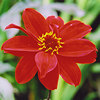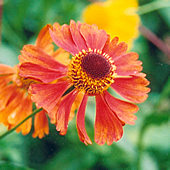1 September 2003 - Late summer turns to autumn
It's turned "back-end-ish", as my mother says. It's definitely autumnal now, quite suddenly. After our heatwave, our proper summer, there's now a chill in the mornings and evenings, and to use another fine old phrase, the nights are "drawing in". I felt quite perturbed by this, as I wanted the summer to carry on forever. As the song says of summertime, the living is easy. Me, I'd like it to be easy all the time.
I always feel that the last two weeks of August are more like autumn than summer. In the garden, the sweet peas are usually all flowered-out, as they were this year, and taking them down always seems to mark the end of the summer garden.
The birds visit often to see where the food might be for the coming winter. Blackbirds, this year's broods, show a change of colouring from juvenile to adult feathers, from speckled to solid brown or black. I'm rather amused by these strange-looking birds tussling with the branches of the rowan tree, consuming its orange berries. Some birds land on the branches and eat the berries they can reach, while others seem to fly at the berries from a nearby branch, pulling them off while in mid-flight.
This year I didn't sow half-hardy annual rudbeckias, or buy young heliotrope plants for bedding out later. So there are not as many late-flowerers in the garden. Most of it, around the edges, is green, in all its shades. In the centre, the flower colour is concentrated in patches. The hot colours of heleniums, anthemis and dahlias still flower, with the perennial rudbeckia that I moved around several times at last recovering and beginning to bloom. In the very centre of the garden are the two plants of the Dahlia "Bishop of Llandaff", the centrepiece of the garden. They are tall, strong plants with dark dramatic leaves and the true red flowers with a thin highlight of yellow around the centre as the flowers open. Above them hang the orange berries of the rowan tree.
Next to the dahlia is the true blue of the Salvia patens, and behind it the pink-flowered fleshy-leaved sedum, just opened recently. The salvia and sedum blend well together, while the dahlia in the foreground seems to be elbowing them out, a real brash star of the late summer garden. The solanums are both flowering - the Solanum jasminoides "Album" has started recently, while Solanum crispum "Glasnevin" has been flowering since May, and shows no signs of stopping.
Autumn might not officially start until September, but for me (and my mother I think - her garden looked very tidy and cleared up by mid-August, I noticed), I feel it comes earlier than that, and with it an urge to start changing things. As part of the adjustment from summer to autumn, I usually feel the need to do some work in the garden. As there are so many plants crammed into a small space, it's definitely not a low-maintenance garden. It needs constant attention if all the plants are to be kept looking good. The stronger ones threaten to smother the smaller ones, while the climbers on the walls need some careful pruning all year round to keep them from spilling out too far onto the pavement, or into next door's garden.
There's not been as much free time this year to look after the garden as much as I've been able to in previous years. My lack of real attention is obvious in the state of the potted hostas, as after my initial care and attention in potting them up fresh and trying to protect them from slugs and snails, I paid little attention to them later, so by July they were shredded, a juicy slug and snail treat. This was proof, if I ever needed any, that you get back what you put in - ie, in this case, if you don't make much effort, you get shredded hostas.
The pond I made last autumn looks well-established now, full of pond plants that have needed some thinning out. The ivy I planted around much of the pond edge has artfully draped itself just as I hoped it would. From it, most evenings, emerges an adult frog or two, while in the rest of the garden, scores of tiny frogs from this year's spawn have been jumping out of their hiding places to surprise me while I'm gardening. Clearing an area under the cherry tree to make room to stand the ladders I needed to prune it meant disturbing many small froglets, all of which were carefully relocated out of harm's way. I can see that the gardening is going to have to be done at a slower pace now the garden is so full of wildlife.
Back to September highlights and diaries


